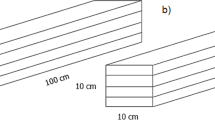Abstract
An experimental laboratory investigation has been carried out into the hot gluing of solid wood layered boards made out of 5.3 mm thick solid-wood lamellas, the latter being produced by the lengthwise veneer cutting technique, the object of the research being to determine some of the reasons (humidity of wood before heating, temperature of wood before cutting into lamellas, and temperature and pressure during the gluing of boards) for the permanent thickness loss which occurs during gluing. Spruce wood (Picea abies (L.) Karst.) was used in the experimental tests. Before cutting into lamellas, this wood was classified into two humidity groups, and heated to three different temperatures. The dried lamellas were used, after suitable preparation, for the two outer layers, which were glued, together with a middle layer of sawn lamellas, by the hot gluing process. A total of 162 laboratory boards, of length 500 mm, width 475 mm and thickness from 24 to 25 mm, were hot glued, using melamin-urea-formaldehyde glue, at three different gluing temperatures and three different gluing pressures. Regression analysis of the measured results of thickness loss showed that the influence of the studied factors on thickness loss was linear, and that thickness loss depends the most on gluing pressure, followed by gluing temperature. It was also found that a higher wood humidity results in a slightly greater thickness loss than the wood’s temperature before cutting into lamellas.
Zusammenfassung
Es wurde das Laborexperiment der Verleimung von Lamellen zu Massivholzschichtplatten in der Heißkontaktpresse durchgeführt, um einige Einflußgrößen (Holzfeuchte vor der Erwärmung, Holztemperatur vor Schneiden der Lamellen sowie Temperatur und Druck während der Plattenverleimung), die zu Dickenverlusten führen, zu untersuchen. Zusammengesetzt wurde das Schichtholz aus 5.3 mm dicken geschnittenen Lamellen aus Massivholz, die nach der für das Längsschneiden von Furnier angewandten Technik geschnitten wurden. Im Experiment wurde Fichtenholz (Picea abies (L.) Karst) verwendet. Dieses wurde vor Zerschnitt zu Lamellen in zwei Feuchtigkeitsgruppen unterteilt und auf drei verschiedene Temperaturen erwärmt. Getrocknete Lamellen wurden für die beiden Außenlagen verwendet und durch Verleimung in der Heißkontaktpresse zu dreischichtigen Massivholzschichtplatten mit der Mittellage aus gesägten Lamellen verleimt. In der Heißkontaktpresse wurden 162 Laborplatten, 500 mm lang, 475 mm breit und 24 bis 25 mm dick, mit Melamin-Harnstoff-Formaldehydleim unter drei unterschiedlichen Temperaturen und drei unterschiedlichen Verleimungsdrücken verleimt. Die Regressionsanalyse der Dickenmeßdaten zeigt eine lineare Auswirkung der untersuchten Einflußgrößen auf die Dickenverluste. Dabei sind die Dickenverluste vorwiegend vom Verleimungsdruck und erst an zweiter Stelle von der Verleimungstemperatur abhängig. Die Prüfung ergab, daß die größeren Dickenverluste im etwas stärkerem Ausmaß auf die Holzfeuchtigkeit während des Zerschneidens von Holz zu Lamellen als auf die Holz-temperatur zurückzuführen sind.
Similar content being viewed by others
References
Armstrong, L. D.; Kingston, R. S. T. 1962: The effect of moisture content on the deformation of wood under stress. Aust. J. Appl. Sci. 13: 257–276
Bodig, J.; Jayne, B. A. 1982: Mechanics of Wood and Wood Composites. Van Nostrand Reinhold Company, New York Cincinnati Toronto London Melbourne.
Currier, R. A. 1962: Compression of Douglas-fir plywood in various hotpressing cycles. Oregon For. Res. Lab., Publ. No. 17
Fukuhara, Y.; Nakazava, H.; Omoto, H. 1976: Studies on the compressibility of wood materials. 2. On the deformation in compression perpendicular to grain of wood veneer. Bulletin of the Utsonomya University Forests, No. 12/13: 17–32
Gupta R. C.; Shah, R. S. 1983: A preliminary note on compression loss in plywood. Indian Forest 109: 159–163
Kelly, S. S.; Rials, T. G.; Glasser, W. G. 1987: Relaxation behaviour of the amorphous components of wood. J. Mater. Sci. 22: 617–624
Kollmann, F. P.; Cote, W. A. 1984: Principles of Wood Science and Technology, Volume I: Solid Wood. Springer-Verlag, Berlin Heidelberg New York Tokyo
Niemz, P. 1983: Physik des Holzes und der Holzwerkstoffe. DRW-Verlag Weinbrenner, Leinfelden-Echterdingen
Resnik, J.; Tesovnik, F. 1994. Thickness loss when gluing veneer sheets into boards in the hot press or by high-frequency. Research report, Dept. of Wood Science and Technology, Biotechnical Faculty, University of Ljubljana, Slovenia, 10 P
Salmen, N. L. 1985: Viscoelastic properties of in situ lignin under water-saturated conditions. J. Mater. Sci. 19: 3090–3096
Author information
Authors and Affiliations
Rights and permissions
About this article
Cite this article
Resnik, J., Šega, B. The influence of certain factors on thickness loss after the hot gluing of cut lamellas into solid wood layered boards. Holz als Roh-und Werkstoff 53, 327–331 (1995). https://doi.org/10.1007/s001070050100
Issue Date:
DOI: https://doi.org/10.1007/s001070050100




